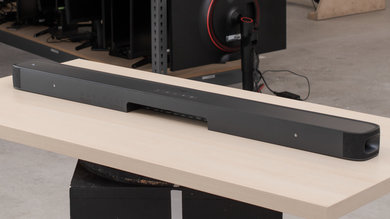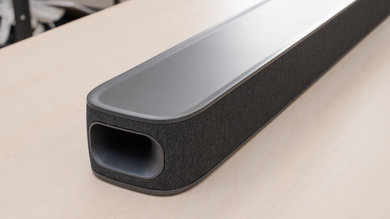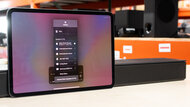The JBL Link Bar is a pretty straightforward 2.0 soundbar that offers a decent sound quality with stereo content. It lacks quite a bit of sub-bass as it doesn't have a dedicated subwoofer and doesn't perform well with surrounds or Atmos content either. On the upside, its sound profile is well-balanced and the bar can get pretty loud. Unfortunately, pushing the bar to its max volume isn't recommended as the bass will be compressed. Nevertheless, the Link Bar is a great option if you have plenty of devices to plug in like a Blu-Ray player and gaming consoles since it has many ports. It also acts as a Google Home speaker and an Android TV Box, which adds to its versatility, although we haven't tested them so we can't comment on how well these features work.
Our Verdict
Decent for mixed usage. It has a decent sound profile that's accurate and well-balanced but lacks a bit of bass. This won't be great for movies and bass-heavy music, but that's about it. If you're simply watching TV and listening to music from time to time, it's a decent option.
-
Decent audio reproduction.
-
Gets loud enough for most content.
-
Plenty of connection options.
-
Acts a Google Home speaker and Android TV Box.
-
Covered by fabric.
-
Lacks sub-bass.
-
Very poor surround performance.
Very good for dialogue and TV shows. The sound profile is well-balanced and fairly neutral, which is great. There's also a 'Voice' EQ preset which makes dialogue and voices clearer and easier to understand. It'll also be easy to cast content like audiobooks or podcasts wirelessly via Bluetooth or Wi-Fi.
Decent for music. This soundbar has a decent audio reproduction but is a bit light on bass. It won't be the best option for bass-heavy music, but other than that, the well-balanced sound profile is fairly versatile for all types of music. It also gets loud enough for a large room and crowded environments, but you might get compression in the bass range if you push it to its max volume.
Mediocre for movies. Due to its speaker configuration, everything will be downmixed to stereo and the listening experience won't be as immersive as what other soundbars that support Atmos can offer.
- 6.7 Mixed Usage
- 7.0 Dialogue/TV Shows
- 7.1 Music
- 6.3 Movies
Changelog
- Updated Apr 08, 2021: Converted to Test Bench 1.0.
- Updated Oct 22, 2020: Changed App support from 'Yes' to 'No'.
- Updated Nov 19, 2019: Review published.
- Updated Oct 28, 2019: Our testers have started testing this product.
- Updated Oct 28, 2019: Early access published.
Check Price
Compared To Other Soundbars
The JBL Link Bar is a straightforward 2.0 soundbar that performs quite well when compared to other 2.0 soundbars we've reviewed. The JBL has a decent and well-balanced sound profile that's suitable for music and dialogue. However, it lacks a bit of sub-bass when compared to 2.1 systems that have a dedicated subwoofer. See our recommendations for the best soundbars, the best budget soundbars, and the best soundbars with subwoofer.
The JBL Link Bar is a better 2.0 soundbar than the Sony HT-S100F. It has a noticeably better audio reproduction and has more bass. Its stereo soundstage is also noticeably wider, and it has more inputs for you to use it as a hub for your devices. It supports DTS content, can cast content wirelessly via Bluetooth and Wi-Fi, and has Chromecast built-in. The JBL is also an Android TV Box and a Google Home speaker. On the other hand, the Sony compresses less at max volume and has a better phantom center performance for clearer voices and dialogue in movies.
The JBL Link Bar is a better soundbar than the Roku Smart Soundbar. Both bars are 2.0 setups lacking a bit of sub-bass, but the JBL has an overall better-balanced sound profile. Unlike the Roku, the JBL supports Chromecast built-in and 4k passthrough, and it also comes with three HDMI In ports, so it's much more versatile. Neither bar supports Atmos content. However, if you want to balance the volume between different programs and commercials, you may prefer the Roku because it has an auto volume feature.
The JBL Link Bar is a decent standalone bar, but the Samsung HW-Q600A is much more versatile overall. The Samsung is a 3.1.2 setup that's better-built and supports Dolby Atmos content, unlike the JBL. It comes with a dedicated sub, too, so it can reproduce a touch more in the bass range. It also comes with more sound enhancement features, including a graphic EQ.
The Sonos Beam is a better soundbar than the JBL Link Bar. The Sonos is easily upgradable, and its 3.0 configuration means it has a dedicated center speaker, which makes dialogue and voices even clearer. It also has way more features like room correction and a night mode. On the other hand, the JBL can play content via Bluetooth and has Chromecast built-in. It also acts as an Android TV box and a Google Home Speaker.
The JBL Link is a better soundbar than the Bose Solo 5. The Bose is rather straightforward, doesn't have many features, and is more of a plug-and-play type of soundbar. The JBL is also an Android TV Box and a Google Home speaker. Its stereo soundstage is also wider, and it has more inputs like full HDMI In ports and an HDMI ARC. It also supports wireless playback via Wi-Fi, on top of Bluetooth.
The Bose Smart Soundbar 700 is better than the JBL Link Bar. The Bose is easily upgradable, but even the bar itself performs better. It has a dedicated center channel, a more balanced sound profile, and offers more sound enhancement features like room correction. Its soundstage is also wider thanks to the positioning of the speakers, which reflects the sound off the walls. However, the JBL has more ports and connectivity options. It has three full HDMI In ports and an audio jack for an AUX cable, which the Bose lacks.
The Yamaha YAS-209 is slightly better than the JBL Link Bar. The Yamaha comes with a wireless subwoofer that has better bass reproduction than the JBL. Its overall sound signature is also a bit more balanced, and it has a better center channel performance, although it's noticeably quieter. On the other hand, if you like Chromecast built-in, the JBL has it while the Yamaha lacks it.
The JBL Link Bar is a slightly better soundbar than the Vizio SB3220n-F6. Both have fairly balanced sound profiles but the JBL packs more bass. The Vizio does have a better stereo soundstage and more sound enhancement features, but the JBL has much better input options, including HDMI support, and can play DTS files.
The JBL Link Bar is a better overall 2.0 soundbar than the Vizio SB3820-C6. The JBL can deliver a more punchy and warm bass, it has an HDMI-in port, and it can support Dolby Digital content. It also has EQ presets. On the flip side, the Vizio has a slightly better center and surround performance, even though it uses a phantom center channel and downmixes surround content into stereo.
The Sonos Arc is better than the JBL Link Bar. The Sonos is a better-built 5.0.2 setup that supports Dolby Atmos content. It has better soundstage, center, and surround performances. It even has a room correction feature, unlike the JBL. However, the JBL comes with EQ presets, which some users may prefer for sound customization.
The JBL Link Bar is a better overall soundbar than the LG SK1. Both are lacking a deep and extended bass. However, the JBL's bass has a slightly better performance that enables it to better reproduce the deep thump and rumble in bass-heavy music and movies. It can also get louder than the LG, though there's a bit of compression at max volume. The JBL also has more customization options, including a dialogue enhancement feature, and far more connectivity options, making it much more versatile.
The JBL Bar 5.0 MultiBeam is better than the JBL Link Bar. Both are standalone setups, but the MultiBeam is the only one that supports height content. It has better center and surround performances, too, as well as a better build quality. Also, it has a room correction feature, which is handy. But if you mostly listen to dialogue-heavy audio like TV shows and music, the Link Bar is still a decent pick.
Test Results
The JBL Link Bar feels decently well-made. It's not as great as other models that are made out of solid plastic. The bar is covered by fabric that can easily be damaged or become dirty. On the upside, the plastic still feels somewhat durable. It's quite similar to Sony soundbars or the Klipsch Bar 48. It's also a 3-in-1 product: a soundbar, a Google Home Speaker, and an Android TV box.
The Link Bar's stereo frequency response is decent. It doesn't have a very deep bass, due to the lack of a dedicated wireless subwoofer, which is disappointing. On the upside, the rest of the response is fairly neutral and well-balanced, which is great for music. For a lower LFE, check out a soundbar with a dedicated subwoofer like the Yamaha YAS-209.
The JBL Link Bar's soundstage is decent. It sounds a little wider than the bar itself, but not by much and it won't be as natural as a home theater setup with dedicated tower speakers. On the upside, the sounds are accurate and come from a pinpoint location.
This soundbar can get pretty loud, more than enough for casual listening. However, when pushing the bar to its max volume, there's some noticeable compression, especially in the bass range.
The JBL Link Bar's stereo THD performance is great. The THD is within good limits at a moderate volume, but does get a bit elevated at max volume. This can result in harsh and impure frequencies.
The JBL Link Bar's center channel performance is mediocre. This is a 2.0 stereo setup, which means it doesn't have a dedicated center channel for voices and dialogue. The bar uses the left and right drivers to simulate a phantom center, which won't be as clear and detailed.
The JBL Link Bar's surrounds performance is pretty bad. Due to the 2.0 configuration, there are no speakers for surround content, meaning the bar can play the content but downmixes it to stereo. This greatly affects the general immersion of surround sounds.
This soundbar doesn't have height channels and can't play Atmos content.
The JBL Link Bar doesn't have many sound enhancement features. You can enhance dialogue when using the EQ preset called 'Voice' and adjust the bass. Other than that, the bar is pretty straightforward and doesn't allow much customization.
The JBL Link Bar has plenty of inputs, including three Full HDMI In, making it easy to use the bar as a hub for your different devices. There's also an AUX cable jack if you want to plug in a cell phone or MP3 player.
Via the ARC port, you'll be able to play Dolby Digital and DTS content, which should cover most streaming services and Blu-ray disc content.
Just like via ARC, you can easily use one of the three Full HDMI In ports to play Dolby Digital or DTS content, on streaming platforms and Blu-ray discs.
Via optical, like most soundbars, both Dolby Digital and DTS are supported.
This soundbar has amazing wireless playback capacities as you can easily cast content to the bar via Bluetooth, or even use your home network too. Additionally, the bar itself is a Google Home speaker and has Chromecast built-in.
Although it accepts the signal for 4:4:4, the result on TVs isn't very crisp and clear, and seems to be subsampling down to what looks like 4:2:2. On the upside, it can do 4k @ 60Hz and HDR10 passthrough, which can be useful for Xbox One users.
The remote is small, sleek, and fits well in the hand. It lets you control pretty much every feature of the bar and you even have a quick access button for Netflix too. Strangely enough, via HDMI ARC, we were able to use that remote to power off the TV, but couldn't turn it back on.
Update 10/22/2020: We originally reported that this soundbar uses Google Home as its companion app. While it can be used with this bar, we now don't consider this to be a companion app as it offers very limited functionality.
This soundbar doesn't have a dedicated app. You can pair it with the Google Home app, but it isn't specifically designed for this bar, and it doesn't really control much of the bar's features. You can adjust its volume output and change a few settings for its ambient mode. It also has a screen mirroring feature, but casting content from dedicated apps will result in better performance.
The JBL Link Bar can automatically enter a power-saving feature and it can be set in the settings. You can either completely turn it off or set it from 30 minutes to up to 6 hours. The bar also supports HDMI CEC, which means you'll also be able to control some aspects of the bar with the TV remote.
Comments
JBL Link Bar: Main Discussion
Let us know why you want us to review the product here, or encourage others to vote for this product.


































